There are places that feel like a secret, hidden just far enough from the everyday world to make the journey itself part of the magic. Cape Verde is one of them.
Floating in the Atlantic Ocean about 350 miles off the West African coast, this archipelago of 12 islands, including 2 uninhabited ones, is where golden beaches meet volcanic mountains and where music, culture, and nature blend into a rhythm all their own.
The islands enjoy sunshine year-round, with average temperatures between 26°C and 30°C, low humidity, and little rain.
The hottest months are from August to October, but truthfully, Cape Verde is a destination you can visit in any season. That’s part of its charm: whenever you arrive, the ocean is warm, the days are bright, and the landscapes are waiting to be explored.
Best Beaches in Cape Verde
Sal Island
When travelers picture Cape Verde, Sal Island is usually the first to come to mind.
This island is almost purpose-built for beach lovers, with wide stretches of golden sand and turquoise waters that glisten under year-round sunshine.
The atmosphere here is easygoing yet vibrant, making it the perfect place to start your beach-hopping journey.
Santa Maria Beach
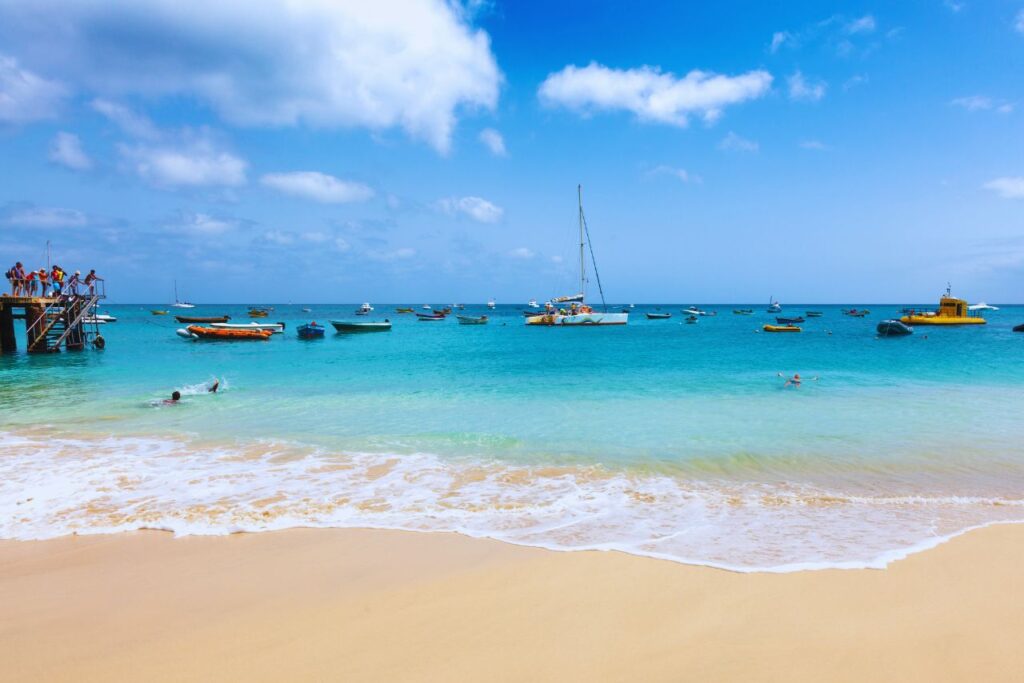
Santa Maria Beach is the island’s crown jewel.
Stretching for about 8 km, this soft white-sand beach is alive with activity.
You can spend the day swimming, sunbathing, or trying out kitesurfing lessons along the breezy shore.
The wooden pier is the heart of it all, where fishermen unload their daily catch, children leap fearlessly into the sea, and visitors gather for sunset strolls.
It’s both lively and local, giving you a true taste of Sal’s coastal life.
Kite Beach
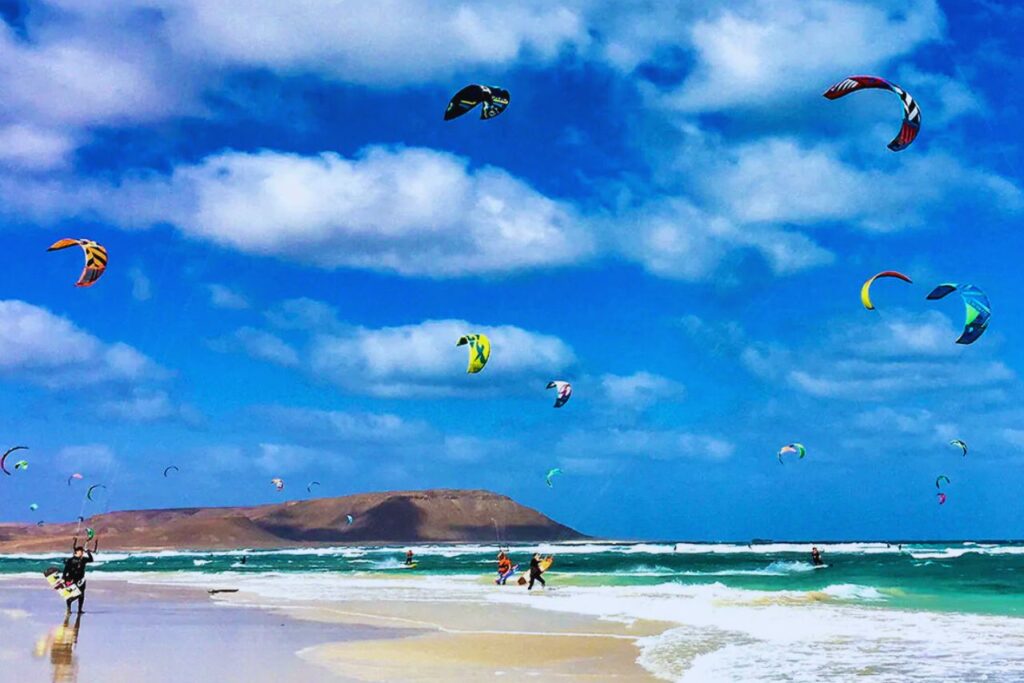
Photo source: ilhadosalofficial
Just a short ride away, Kite Beach bursts with energy and color.
Known worldwide for its consistent winds, it’s one of the best places to learn or master kitesurfing.
The sight of dozens of kites soaring against the Atlantic sky is unforgettable, and schools along the shore make it easy for beginners to join in.
Even if you’re not riding the waves, simply watching the action is a thrill.
Ponta Preta Beach
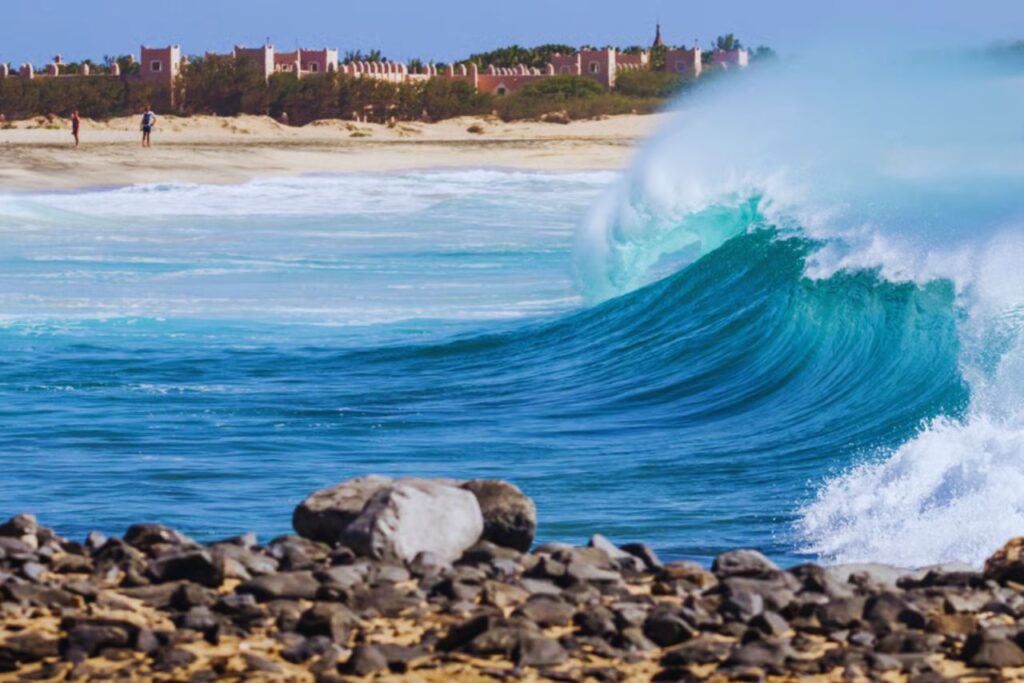
Photo source: kiteguide
For those chasing adrenaline, Ponta Preta Beach is where the Atlantic puts on a show.
It’s one of the world’s most celebrated windsurfing and wave-riding destinations, with big swells drawing surfers from around the globe.
Even if you don’t surf, it’s worth a visit just to feel the power of the ocean and watch the pros carve through towering waves.
Shark Bay
A completely different experience awaits at Shark Bay, where shallow waters become home to schools of lemon sharks.
Local guides offer safe tours that take you right into the shallows, where you can stand just meters away as these sleek, harmless creatures glide gracefully around you.
It’s thrilling, humbling, and unlike any other beach experience in Cape Verde.
READ ALSO: 8 Fairytale Towns in Africa to Visit Now
Boa Vista Island
If Sal is lively, Boa Vista is wild and unspoiled.
Its beaches stretch on for miles, often with no one else in sight, offering the kind of seclusion that feels rare in today’s world.
This island is the place to lose yourself in raw beauty, where golden sand meets a turquoise Atlantic and the desert seems to roll straight into the sea.
Santa Monica Beach
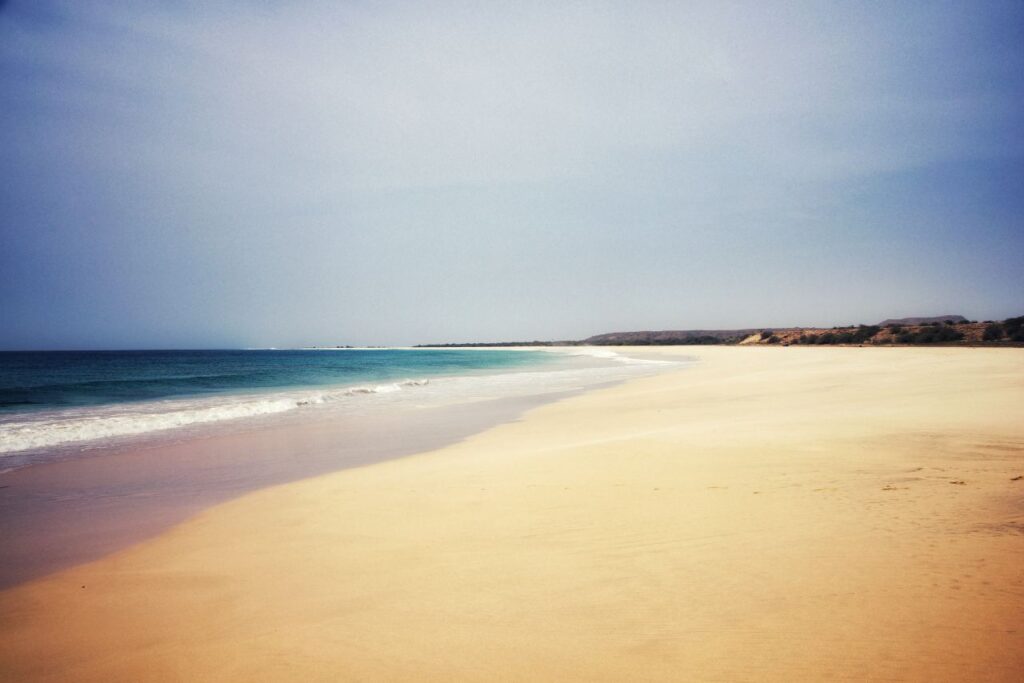
The most famous is Santa Monica Beach, a 22 km sweep of soft sand often described as Cape Verde’s best beach.
Vast and untouched, it gives you space to wander for hours with only the crash of waves for company.
It’s a place where you can clear your head, breathe deeply, and let time slow down.
Though swimming can be tricky due to strong currents, the sense of freedom and solitude here is unforgettable.
Praia de Chaves
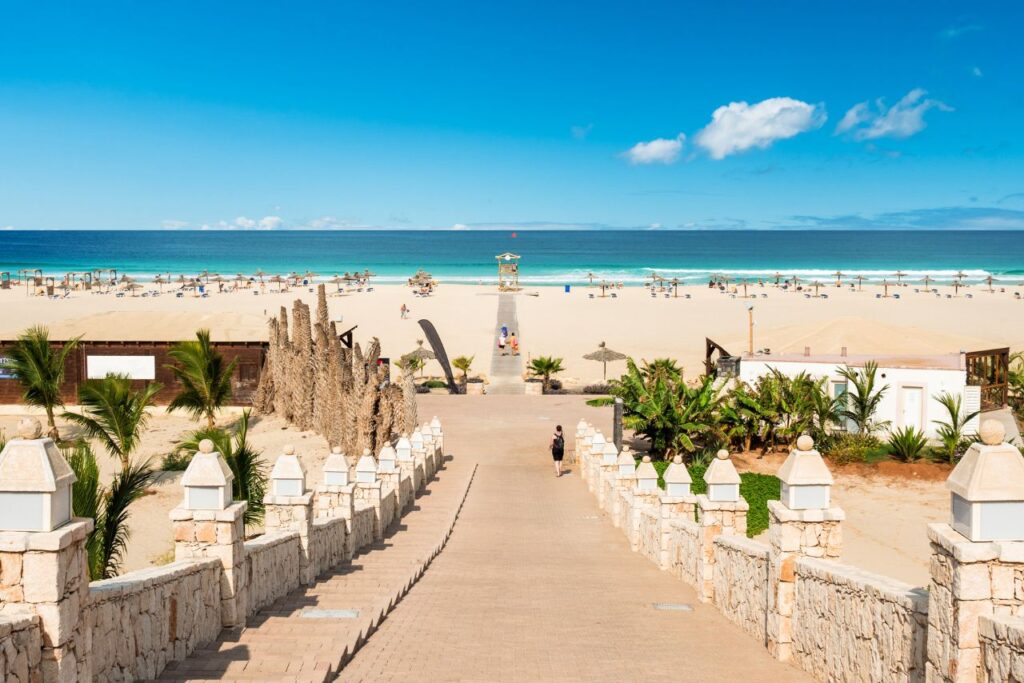
Closer to Sal Rei, the island’s main town, you’ll find Praia de Chaves.
This beach is where rolling dunes tumble into the ocean, creating a dreamlike landscape. Small beach bars scatter along the shore serving cold drinks and grilled fish, but it never feels crowded.
Sit back under the shade of a thatched roof, toes buried in sand, and you’ll feel a world away from everything.
READ ALSO: Dakar City Guide (Senegal): Culture, Music, and Island Escapes
Maio Island
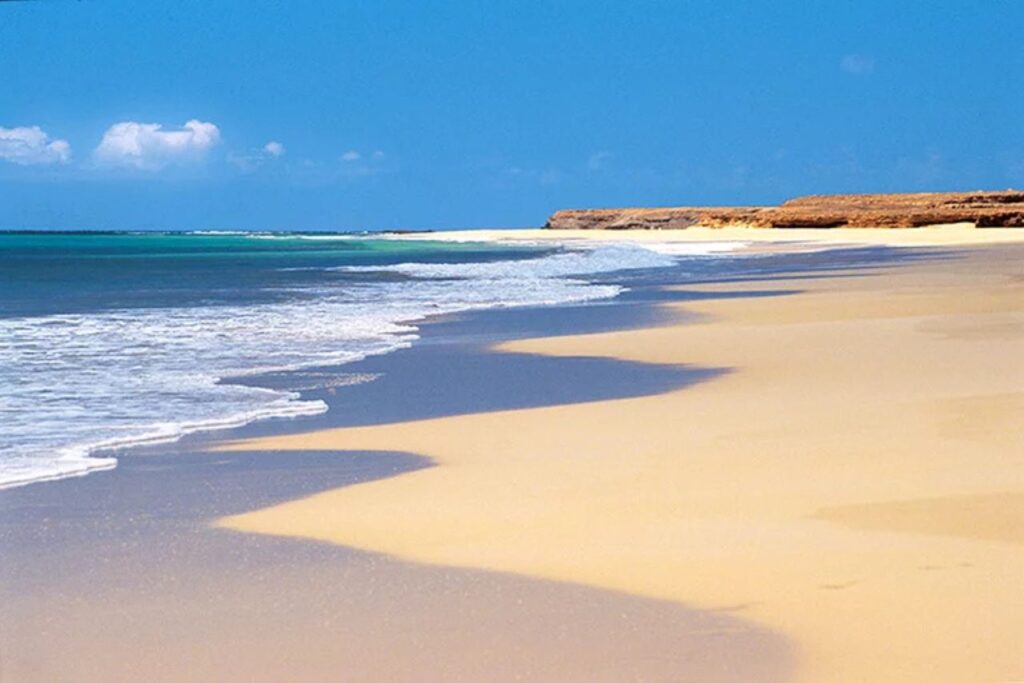
Photo source: capeverde
Maio is peaceful. Often overlooked by travelers, this island feels like Cape Verde’s best-kept secret. Life moves slowly here, and the beaches reflect that gentle rhythm.
What makes Maio special is its balance of beauty and authenticity.
There are no massive resorts or crowded strips, just friendly guesthouses, local cafés, and beaches that feel timeless.
It’s a reminder that sometimes the best luxury is space, silence, and a horizon that belongs only to you. It’s the island to visit when you want simplicity, quiet, and a true connection to Cape Verdean life.
São Vicente
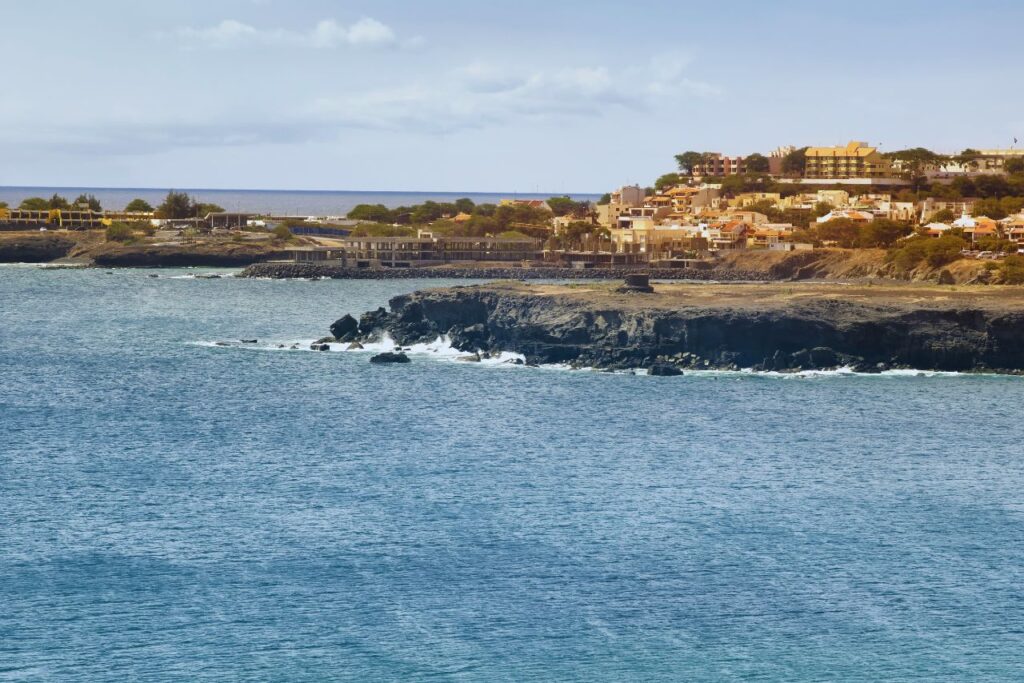
If you want to dive into Cape Verde’s cultural heartbeat, São Vicente is the island to stay on.
Its capital, Mindelo, is known for music, art, and nightlife that spill out from cafés and bars into the streets.
This is the birthplace of Cesária Évora, the legendary “barefoot diva,” and music still fills the city, from live morna in small taverns to lively carnival parades that bring the town alive every February.
READ ALSO: Lagos City Guide: Beaches, Nightlife, and Hidden Gems in Nigeria
Best Hiking in Cape Verde
Santo Antão
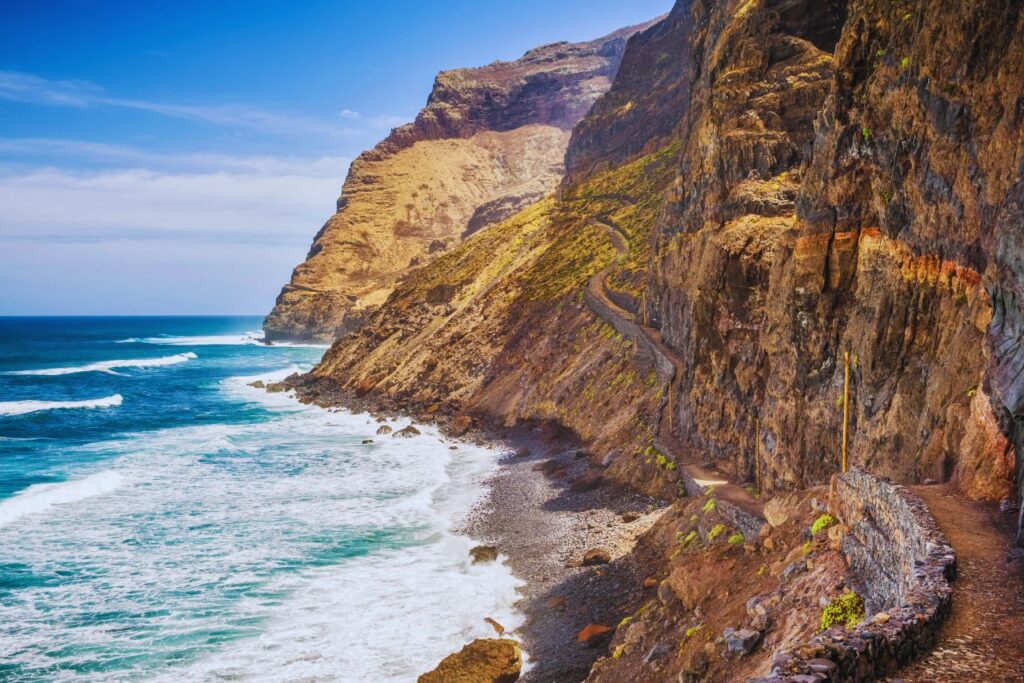
Santo Antão is Cape Verde’s hiking heart.
The island is all sharp ridges, lush valleys, and deep ravines, making it the top destination for walkers and nature lovers.
The famous trail from Cova Crater down to Paul Valley is a must: it begins at the rim of an ancient volcanic crater before winding through terraced hillsides covered with sugarcane and banana plants.
Along the way, you’ll meet friendly locals farming the land, and every turn opens up to views that make you stop in awe.
Beyond the Paul Valley, the island offers dozens of trails that feel like stepping into another world.
The paths are well-marked, but rustic, so you’ll need good shoes and time to take it all in.
From Ribeira Grande to Ponta do Sol, coastal hikes reveal dramatic cliffs and tiny villages clinging to the mountainside.
Santo Antão is not just hiking, it’s hiking with soul.
Brava

Photo source: adventurous-travels
Known as the Island of Flowers, Brava is Cape Verde’s smallest inhabited island but it hides spectacular hiking routes.
The volcanic cliffs drop steeply into the sea, while inland you’ll find a surprisingly fertile landscape filled with hibiscus, bougainvillea, and fruit trees.
Walking here feels intimate, you’re never far from local homes, winding paths, and bursts of colorful flowers.
One of the most rewarding hikes is from the town of Nova Sintra down to Fajã de Água, a tiny coastal settlement with natural swimming pools.
The trail takes you through green valleys and along ridges with sweeping sea views.
Brava feels untouched and remote, and hiking here is a chance to slow down, breathe, and take in Cape Verde’s quieter beauty.
Santiago
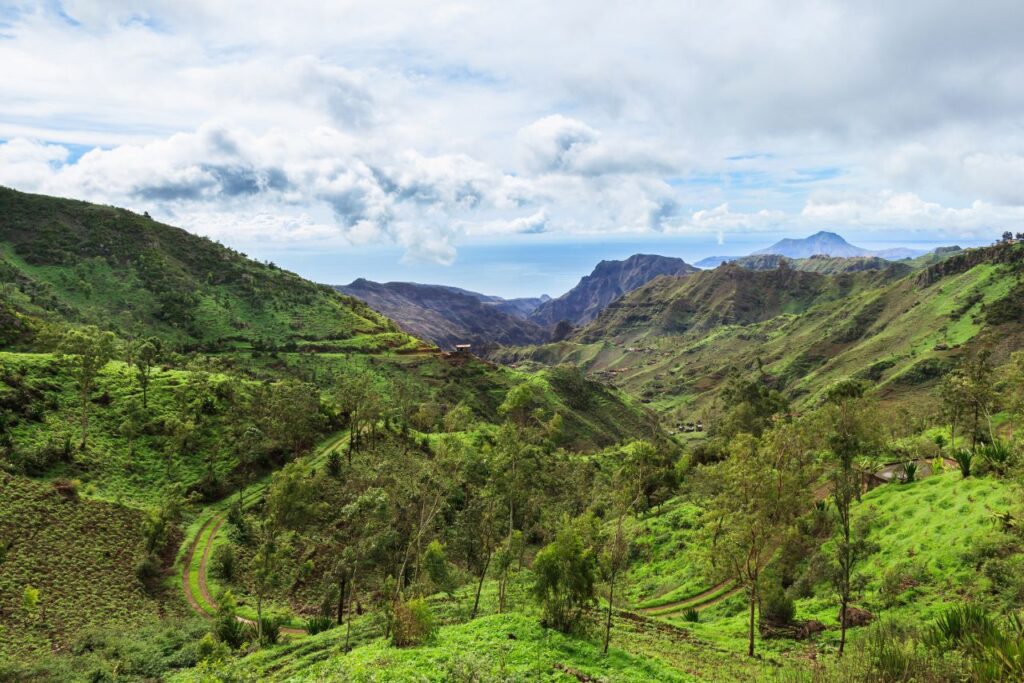
As the largest island, Santiago blends Cape Verde’s history with its landscapes.
Hiking here is about more than just nature, it’s about connecting with the island’s past and culture.
The trek up Pico de Antónia, the highest peak on Santiago, offers panoramic views that stretch from the mountains to the ocean. It’s challenging, but the sense of achievement at the summit is unforgettable.
For a gentler experience, the Serra Malagueta Natural Park has marked trails through forested hills, valleys, and viewpoints overlooking the sea.
Along the way you’ll see endemic plants and, if you’re lucky, catch sight of rare bird species.
Hiking in Santiago offers variety: rugged climbs, cultural paths near historic Cidade Velha, and routes that make you feel Cape Verde’s heartbeat.
São Nicolau
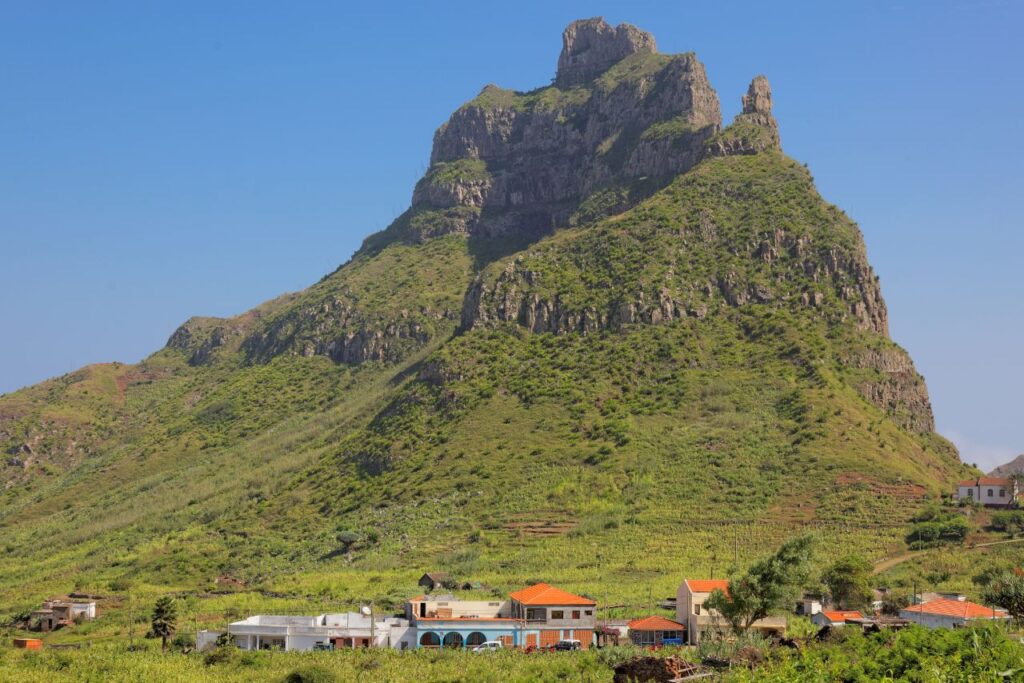
Less visited than Santo Antão but equally rewarding, São Nicolau is a hiker’s dream.
The island is greener than many expect, with fertile valleys and jagged mountains rising suddenly from the sea.
Trails here are quieter, offering solitude and a sense of discovery.
The highlight is the trek to Monte Gordo, the island’s highest peak. The trail cuts through eucalyptus groves and farmland before opening up to sweeping views of the island and the ocean beyond.
There are also coastal walks linking villages like Tarrafal and Ribeira Brava, where you can stop for a home-cooked meal after your hike.
São Nicolau is the kind of place where every step feels authentic, as if you’ve stumbled upon a secret the rest of the world hasn’t yet found.
READ ALSO: Banjul Travel Guide: Exploring The Gambia Beyond the Beaches
Where to Stay in Cape Verde
Cape Verde’s charm lies not just in its beaches and mountains but also in the places you can call home while exploring.
Each island offers something different, from sleek seaside resorts to family-run guesthouses tucked into mountain valleys.
Wherever you stay, you’ll find warm hospitality and a pace of life that invites you to slow down. (All locations linked from Bookings.com and Tripadvisor.com)
In Sal Island
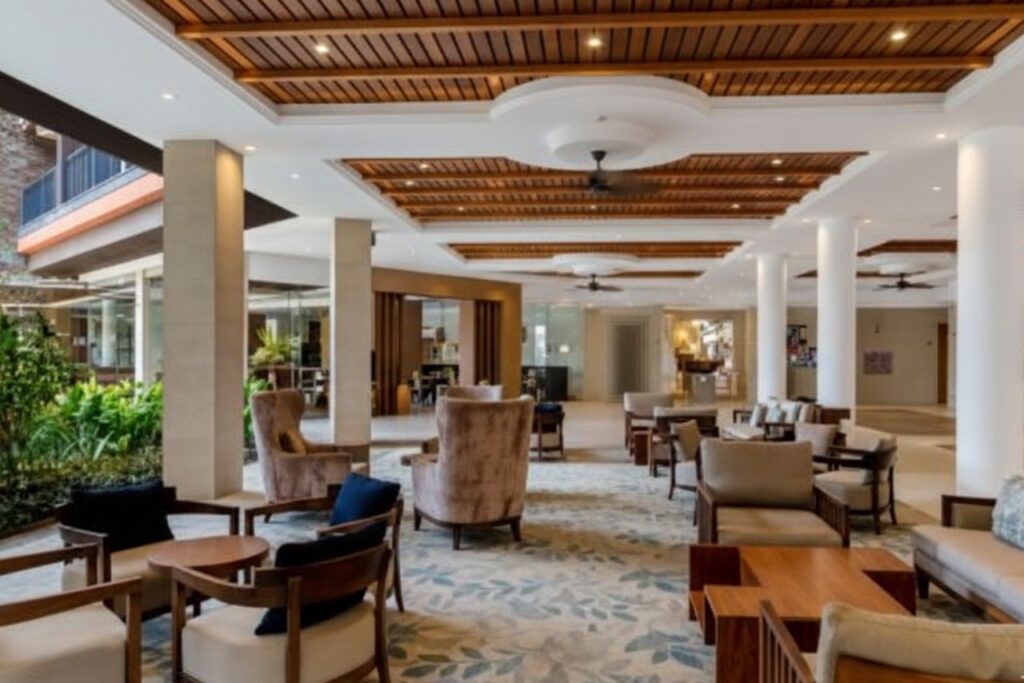
Photo source: Bookings.com
Sal is the most developed island for tourism, so accommodation ranges from luxury resorts to smaller boutique stays.
On Santa Maria Beach, you’ll find the Hilton Cabo Verde Sal Resort, a modern beachfront choice with pools and restaurants just minutes from the airport.
For those wanting an all-inclusive experience, Hotel Riu Funana and Melià Tortuga Beach Resort & Spa offer full-service escapes right on the sand.
If you’d prefer something with more character, Hotel Morabeza remains a classic choice in Santa Maria, combining Cape Verdean charm with a central location.
Travelers on a mid-range budget can try Ocean Suites or Hotel Dunas de Sal, which provide comfort without the crowds of the big resorts.
Boa Vista Island
Boa Vista is quieter than Sal, but you’ll still find excellent places to stay, particularly around Sal Rei.
Hotel Dunas Ilha da Boavista is well-reviewed for its comfort and proximity to the beach, while B&B Sereia Azul and Cala Da Lua Apartments are great options if you’re looking for a personal, family-run experience.
Many of these guesthouses can also help arrange turtle-watching tours or dune excursions, giving you a direct link to the island’s natural wonders.
Maio Island
Maio is Cape Verde’s secret gem, with a much slower rhythm than Sal or Boa Vista.
The stays here are small and personal. Kaza Tropikal and Wave Maze offer cozy lodging with warm hosts, while Hotel AH Maio and BarracudaMaio bring a touch of modern comfort to the island.
Booking ahead is wise, since options on Maio are limited and fill up quickly.
São Vicente Island
Known as the cultural heart of Cape Verde, São Vicente, especially its capital Mindelo, is full of character.
Boutique stays like Kira’s Boutique Hotel and Casa Café Mindelo combine style with tradition, while Pousada B&B Le Gourmet and Solar Windelo offer cozy, welcoming atmospheres in the city center.
If you want something simpler, Arla Residential provides basic comfort at great value.
Santo Antão
For hikers and nature lovers, Santo Antão offers eco-lodges and mountain guesthouses.
Hotel Santantao Art Resort in Porto Novo is one of the island’s few larger hotels, but many travelers prefer the rustic charm of guesthouses like Casa Santa Barbara Deluxe, or Kasa d’Vizin in Ponta do Sol.
READ ALSO: Accra Travel Guide (Ghana): Best Things to Do, See & Eat in 2025
Brava Island
Brava, the island of flowers, is small and peaceful, so lodging options are limited but memorable.
Hotel Cruz Grande-Brava in Nova Sintra offers comfort in the island’s charming capital, while Djabraba’s Eco-Lodge is a favorite for travelers who want a more rustic, nature-focused stay.
Seaside options like Fajã Beach House let you wake up close to the ocean. On Brava, accommodation feels more like staying in a home than a hotel, which matches the island’s tranquil, close-knit vibe.
Santiago Island
As Cape Verde’s largest island, Santiago has the widest range of stays.
In Praia, you’ll find modern hotels such as Pestana Tropico Hotel, perfect for travelers who want access to the city’s markets, restaurants, and nightlife.
For more personal touches, many guesthouses and eco-lodges are tucked into the countryside and mountain villages.
If history draws you, lodgings in Cidade Velha let you sleep near Cape Verde’s UNESCO heritage sites.
Tips When Choosing Lodging
- Match your stay to your itinerary: Stay near the beaches you plan or trails you want, so you don’t lose time on roads.
- Book early: Especially on islands with fewer options (Brava, Maio, São Nicolau).
- Check amenities: Some remote guesthouses may not have strong WiFi, air conditioning, or onsite restaurants. Be ready.
- Ask for transfers or pick-ups: If your lodging is in a mountain valley or off main roads, see whether they offer airport or ferry pick-up.
- Support local: Many guesthouses are family-run. Your stay can sustain local economies and add authentic flavor to your trip.
Final Thoughts
Cape Verde is the kind of place that keeps calling you back.
Each island has its own soul, some soft and sandy, some wild and volcanic, some rich with music and culture.
Together they form an archipelago that feels like a hidden corner of the world, still unspoiled enough to feel like a discovery, yet welcoming enough to feel like home.
If you’ve been waiting for the right time to take a trip that blends relaxation with adventure, Cape Verde is ready for you.
Beaches that stretch for miles, hikes that test your limits, and stays that suit every style; they’re all waiting across these islands in the Atlantic.
Pack light, travel open-hearted, and let Cape Verde change how you see the world.







